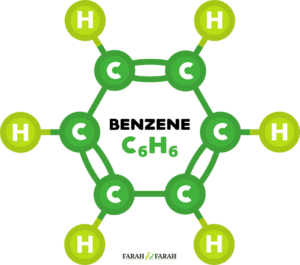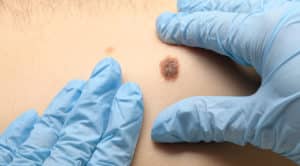Benzene Sunscreen Recall Lawsuit
Sunscreen is meant to protect your skin from harmful UV rays from the sun. Without it, you risk sunburn and even skin cancer. Johnson & Johnson has recalled multiple types of sunscreen due to the discovery of low levels of the chemical benzene in the products. Benzene is considered a carcinogen, which means that it can cause cancer in humans. It can be absorbed through the skin and can cause health problems such as anemia, multiple myeloma, Non-Hodgkin’s lymphoma, and several types of leukemia.
Home » Product Liability Attorneys » Benzene Sunscreen Recall Lawsuit
Sunscreen is necessary to protect ourselves from sunburn and the risk of melanoma if we’re going to spend time outdoors. It’s vital that sunscreen not only does its job to protect our skin, but also does not put us at risk of further harm. This is especially important because the risk of melanoma has increased across the world.
Johnson & Johnson and other sunscreen manufacturers have recalled certain sunscreen and aloe vera products due to the presence of the harmful chemical benzene. While benzene isn’t an ingredient in any of the recalled products, the chemical was still detected in several sunscreen and aloe vera products that have now been recalled.
If you or a loved one has used any of the recalled sunscreen or aloe vera products and has developed leukemia, Non-Hodgkin’s lymphoma, multiple myeloma, or anemia as a result, you may have a case against the company that manufactured the product. Contact Farah & Farah for a free consultation. Our attorneys at Farah & Farah are highly experienced with litigation against corporations. Let us help you seek the justice and compensation you may be eligible for. You won’t have to pay anything unless your case is successful.
What Is Benzene?
Benzene is a highly flammable chemical used in the production of other chemicals, pesticides, plastics, lubricants, and more. It has a sweet smell and is a liquid when it’s at room temperature. In liquid form, it’s either a pale yellow color or colorless. Benzene very quickly evaporates but its gaseous form is heavier than that of the air, so it sinks to lower-lying areas. Benzene can dissolve in water, but only a little bit, and typically floats on top of the water instead of fully dissolving.

How Does Benzene Form?
Benzene can be formed both naturally or artificially by humans. In nature, benzene is found in volcanoes and forest fires. You can also find it in gasoline, cigarette smoke, and crude oil. Benzene’s presence in gasoline means that it can also be found in the exhaust of motor vehicles.
What Is Benzene Used to Make?
Benzene is actually one of the most-used chemicals in the United States, ranking in the top 20. It’s used to make:
- Pesticide
- Drugs
- Rubber
- Lubricant
- Dye
- Detergent
Benzene is also sometimes used to make other chemicals. These other chemicals are then used in a variety of industries to produce:
- Synthetic fiber
- Nylon
- Plastics
- Resin
Benzene Exposure
Most people who are exposed to benzene breathe it in. However, there are other ways you can be exposed to dangerous chemicals. It’s possible to absorb benzene into the body through the skin. Those who work in an industry that uses benzene to manufacture a product may be at risk of exposure at work. The people most at risk to be exposed to benzene in the workplace include:
- Firefighters
- Gas station employees
- Printers
- Lab technicians
- Steelworkers
It’s also possible to be exposed to benzene via a consumer product or in nature. In both urban and rural areas, benzene can be found in the air, but the levels are typically low enough to not pose a problem. People who don’t work with benzene can still be exposed to it through the following:
- Gasoline fumes
- Car exhaust
- Factory emissions
- Industrial wastewater
- Gas stations
- Proximity to industrial areas
- Heavy traffic
- Enclosed spaces with unventilated fumes from:
- Glue
- Solvent
- Gas
- Paint
- Art supplies
- Smoking
- Secondhand smoke
Risks of Benzene Exposure
Benzene is dangerous to humans because it can prevent your cells from working properly. What damage benzene can do depends on how much you’ve been exposed to, how long you were exposed to it, and how you were exposed to it. Your age and overall medical condition can also affect how exposure to benzene could impact your health. Those with pre-existing medical conditions would be more at risk for a more extreme reaction.
Benzene has been linked to different types of leukemia, multiple myeloma, and anemia. This is because benzene can impact the immune system, decreasing the number of white blood cells by changing the levels of antibodies in the blood. It can also cause anemia by preventing bone marrow from producing enough red blood cells.
Symptoms of Benzene Exposure
The immediate symptoms of benzene exposure via breathing can include:
- Dizziness
- Drowsiness
- Rapid heartbeat
- Irregular heartbeat
- Confusion
- Tremors
- Unconsciousness
- Headaches
- Death
Those who are exposed to benzene via ingesting food or drink may experience the following symptoms:
- Dizziness
- Sleepiness
- Convulsions
- Vomiting
- Stomach irritation
- Rapid heartbeat
- Irregular heartbeat
- Death
Long-Term Effects of Benzene Exposure
While benzene can cause immediate effects after exposure, there are also negative effects of long-term exposure to benzene. The most common effect of long-term exposure to benzene is usually on the blood and the bone marrow. Benzene can impact both the red blood cells and the white blood cells. Benzene exposure has been linked to the following:
- Acute Myeloid Leukemia
- Acute Lymphocytic Leukemia
- Chronic Lymphocytic Leukemia
- Myelodysplastic Syndrome
- Non-Hodgkin Lymphoma
- Multiple Myeloma
- Aplastic Anemia
What Is Anemia?
Anemia is a condition in which your body isn’t making enough red blood cells. As a result, your blood can’t carry enough oxygen to properly fuel your body, leaving people who are anemic feeling tired and weakened.
SYMPTOMS OF ANEMIA
The symptoms of anemia can include:
- Weakness
- Fatigue
- Pale skin
- Yellowish skin
- Headaches
- Cold hands
- Cold feet
- Shortness of breath
- Dizziness
- Lightheadedness
- Chest pain
- Irregular heartbeat
What Are Myelodysplastic Syndromes?
Myelodysplastic syndromes are a set of blood cell disorders. In a myelodysplastic syndrome, the red blood cells don’t work properly or aren’t formed properly. Usually, myelodysplastic syndromes occur because something is wrong with the bone marrow.
SYMPTOMS OF MYELODYSPLASTIC SYNDROMES
The symptoms of myelodysplastic syndromes can include:
- Frequent infections
- Red spots just beneath the skin
- Shortness of breath
- Fatigue
- Paleness
- Easy bruising
- Unusual bruising
- Easy bleeding
- Unusual bleeding
Some of these symptoms are caused by a low white blood cell or red blood cell count. For example, anemia occurs when you have a low red blood cell count and can cause fatigue and paleness. Bleeding and bruising can be caused by a low blood platelet count. A low white blood cell count can hinder your ability to fight infections.
What Is Multiple Myeloma?
Multiple myeloma is a cancer of the plasma cells. Plasma cells are a type of white blood cell that is responsible for making antibodies to recognize and attack germs, helping you fight off infections. When someone has multiple myeloma, the cancerous plasma cells gather in the bone marrow and drive out the healthy cells. This means that instead of healthy plasma cells producing antibodies, cancerous plasma cells are instead producing abnormal proteins.
SYMPTOMS OF MULTIPLE MYELOMA
Symptoms of multiple myeloma can include:
- Constipation
- Bone pain
- Appetite loss
- Nausea
- Fatigue
- Weight loss
- Weakness in the legs
- Numbness in the legs
- Confusion
- Mental fog
- Frequent infections
- Excessive thirst
What Is Non-Hodgkin’s Lymphoma?
Non-Hodgkin’s lymphoma is a cancer of the lymphatic system. The lymphatic system is a part of the body’s immune system and helps to fight germs. When someone has non-Hodgkin’s lymphoma, the lymphocytes, which are a type of white blood cell, don’t grow properly. When this happens, they can form abnormal growths and tumors throughout the body.
SYMPTOMS OF NON-HODGKIN’S LYMPHOMA
Symptoms of non-Hodgkin’s lymphoma can include:
- Abdominal pain
- Abdominal swelling
- Swollen lymph nodes
- Chest pain
- Coughing
- Difficulty breathing
- Fatigue
- Weight loss
- Night sweats
- Fever
What Is Leukemia?
There are a variety of different types of leukemia. All kinds of leukemia are cancers of the tissues that form the body’s blood supply, including the lymphatic system and the bone marrow. Usually, leukemia affects the white blood cells by causing excessive amounts of abnormal white blood cells to be produced. Abnormal white blood cells don’t function properly and therefore hinder your body’s ability to heal and fight off germs and infections.
SYMPTOMS OF LEUKEMIA
While the symptoms of leukemia can vary depending on the type of leukemia, there are some common symptoms, which can include:
- Weight loss
- Frequent infections
- Severe infections
- Fever
- Chills
- Weakness
- Fatigue
- Swollen lymph nodes
- Enlarged spleen
- Enlarged liver
- Easy bruising
- Easy bleeding
- Red spots on the skin
- Nosebleeds
- Bone pain
- Bone tenderness
- Excessive sweating (usually at night)
WHAT IS ACUTE MYELOID LEUKEMIA?
Acute myeloid leukemia (AML) is a cancer of the bone marrow and the blood. It’s called acute because of it progresses rapidly. The myeloid in its name refers to the myeloid cells that the cancer affects. Myeloid cells develop into platelets, white blood cells, and red blood cells. The symptoms of acute myeloid leukemia can include the following:
- Bone pain
- Fever
- Easy bruising
- Unusual bleeding
- Frequent nosebleeds
- Bleeding gums
- Fatigue
- Lethargy
- Pale skin
- Shortness of breath
- Frequent infections
WHAT IS ACUTE LYMPHOCYTIC LEUKEMIA?
Acute lymphocytic leukemia (ALL) also affects the blood and the bone marrow. In particular, it affects the white blood cells called the lymphocytes, which can help the body fight off infections. As an acute form of leukemia, it progresses rapidly. The symptoms of ALL can include:
- Fever
- Frequent infections
- Bone pain
- Bleeding gums
- Frequent nosebleeds
- Severe nosebleeds
- Pale skin
- Shortness of breath
- Swollen lymph nodes
- Weakness
- Fatigue
- Decrease in energy
WHAT IS CHRONIC LYMPHOCYTIC LEUKEMIA?
Chronic lymphocytic leukemia (CLL) is similar to acute lymphocytic leukemia in that it also affects the lymphocytes. This form of leukemia progresses more slowly and is therefore called chronic instead of acute. The symptoms of CLL can include:
- Enlarged lymph nodes
- Weight loss
- Night sweats
- Frequent infections
- Fever
- Pain in the upper abdomen (due to spleen swelling)
- Fatigue
What Is the Link Between Benzene and Sunscreen?
Online pharmacy Valisure found the benzene in affected sunscreen products in May of 2021. Johnson & Johnson did not issue a recall of any of the affected sunscreen products until July of 2021, allowing the products to continue being purchased, exposing consumers to benzene without their knowledge.
Benzene is not an active ingredient in either sunscreen or aloe vera gels. However, small amounts of benzene were discovered in samples of finished sunscreen products. Johnson & Johnson admitted that traces of benzene were found in samples of their aerosol sunscreen products and while they believed that the amount was negligible, they recalled all affected products anyway.
Sunscreen Product Recalls
Johnson & Johnson, the manufacturer of most of the affected sunscreen products, issued a voluntary recall in July 2021 of the following products:
- Aveeno Protect + Refresh aerosol sunscreen
- Neutrogena Invisible Daily defense aerosol sunscreen
- Neutrogena Ultra Sheer aerosol sunscreen
- Neutrogena Beach Defense aerosol sunscreen
- Neutrogena Cool Dry Sport aerosol sunscreen
Johnson & Johnson also advised that any consumers using those products immediately stop using that product and switch to an alternate, unaffected type of sunscreen. It’s important to continue to use sunscreen, so no one should stop using sunscreen altogether. Johnson & Johnson suggested that consumers should properly dispose of the sunscreen and then that they could contact Johnson & Johnson at 1-800-458-1673 for a refund on their sunscreen. Additionally, Johnson & Johnson advised all retailers who sold the affected products of the recall and arranged for their return.
Anyone who has health-related concerns due to using one of the affected aerosol sunscreen products should speak with their doctor.
Why Is Sunscreen So Important?
It’s important to wear sunscreen outside. This is to protect your skin from the harmful UV rays that come from the sun’s rays. UV rays can be a danger even if it’s not a sunny day. Plus, melanoma rates are rising, so it’s even more important for people to protect themselves with sunscreen. Sunscreen is a necessary product for anyone wanting to protect themselves from the risk of skin cancer while spending time outside. It’s therefore vital that sunscreen products not increase the risk of other cancers and health conditions while protecting you from melanoma.

WHAT IS MELANOMA?
Melanoma is the most severe type of skin cancer. It occurs in the melanocytes, which are the skin cells that produce your skin color. Melanoma isn’t restricted to forming on the skin, however, and can also occur on the eyes, or even inside the body, such as in the throat or in the nose. The symptoms of melanoma can include:
- New pigmented growth on the skin
- Unusual growth on the skin
- Change to an existing mole
It’s normal to have moles. A normal mole is typically uniform in color, is about the size of a pencil eraser or smaller, has clear edges, and is either round or oval. Melanomas are usually irregular in shape, have irregular borders, are larger than a pencil eraser, are of different colors, and continue to change over time.

Benzene Sunscreen Class Action Lawsuits
Class action lawsuits have been filed on behalf of consumers who purchased Neutrogena or Aveeno aerosol sunscreen that were found to have benzene in them. The plaintiffs of the lawsuits claim that Johnson & Johnson failed to properly label their products with a warning of the risk of benzene exposure. The plaintiffs also claim that the failure of Johnson & Johnson to warn of the risks of benzene exposure caused consumers to incur a monetary cost because they relied on Johnson & Johnson’s stated ingredients list to choose which sunscreen to purchase.
The class action lawsuits have recently been filed and as of yet there has been no settlement against Johnson & Johnson or any other company that had sunscreen products affected by benzene contamination.
Should I Consider a Benzene Sunscreen Lawsuit?
You may have a case against Johnson & Johnson or another sunscreen manufacturer if you have used any of the following products:
- Neutrogena Ultra-Sheer Weightless, SPF 100+
- Neutrogena Ultra-Sheer Weightless, SPF 70
- Sun Bum Cool Down Gel
- Neutrogena Beach Defense Oil-Free Body Spray, SPF 100
- CVS Health After-Sun Aloe Vera Soothing Spray
- Neutrogena Beach Defense Body Spray, SPF 50
- Neutrogena Invisible Daily Defense Body Sunscreen Broad Spectrum, SPF 60+
- Fruit of the Earth Aloe Vera Gel
And have also developed any of the following health conditions, as a result of product use:
- Acute Myeloid Leukemia
- Acute Lymphocytic Leukemia
- Chronic Lymphocytic Leukemia
- Myelodysplastic Syndrome
- Non-Hodgkin Lymphoma
- Multiple Myeloma
- Aplastic Anemia
Farah & Farah is dedicated to getting consumers the justice and compensation that they deserve. If you or a loved one has had their health impacted by the exposure to benzene through the use of any of the affected sunscreen products, you may be eligible for compensation for lost wages, medical costs, and pain and suffering. Don’t hesitate to contact Farah & Farah for your free consultation. You won’t have to pay a dime unless your case is successful.
Co-counsel will be associated on these cases.

free case review
Related Pages
Client Testimonials

Related Blogs













